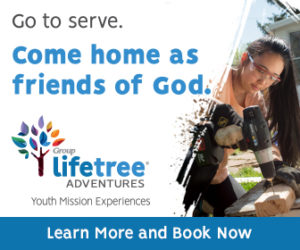The van-ride home from a retreat or trip alternates between chaos and peace as kids relive highlights from the week. The caffeine is finally wearing off, and the exhaustion is setting in. If you’re like me, when I pull the van into the church parking lot I have two emotions sweep over me: relief that we made it home, and a kind of sadness that the experience is over. My students have grown in their relationships with friends, leaders, and God. And for some, the time away has been a welcome respite from a difficult home life—family stress, temptations, unhealthy relationships, even uncertainties about when (and how much) they’ll eat.
And now… we’re back. Normalcy is about to kick in. The kids pile out, muck out their cups and candy wrappers, then collect their gear from our trailer. What happens next never ceases to amaze me. While some parents get out of their cars to greet their kids, many do not. If it’s an evening arrival, I can see the soft glow of their phones, revealing a hint of the disconnect that’s about to happen at home.
Of those who do get out of their cars, only a few actually smile and embrace their kids—most don’t even ask about the week. I can’t help but wonder what these kids are going home to—how will they process and unpack their week when they’re entering the cold reality of their distracted and even uncaring home? So I scour social media sites for information—to get a peek behind their front door. Here’s a typical post-trip post from a student at a previous church:
That moment when you get home from being gone for a week, and your parents aren’t really excited to see you, there’s a silent ride home, and when you get home you sit alone in the family room while everyone does their own thing. Even when you ask to do something. So happy I’m home. So happy.
This is heartbreaking stuff. This student’s emotional reality reminds me of Moses in Exodus 34—he’s returning from a transforming experience, his second trip back down from the summit of Mount Sinai. His face is aglow, and he has stone tablets in hand, ready to pass on the epic words of God to his people. But the people see Moses and are afraid to come near him. As bizarre as it sounds, Moses must have felt much the same way that our students do after their own deeper encounters with God.
I think we can study what Moses said and did for wisdom that will guide us as we help our students get the most out of their own trip up-and-down the mountain:
1. The Lord tells Moses to come prepared to meet him.
Moses was told to cut two stone tablets and be ready in the morning to present himself to God. Likewise, we can prepare our students for their own epic encounters with God. Sure, they need to bring sleeping bags, extra clothes, Bibles, pens—all the stuff of trips. But they also need to be prepared to meet God.
God was clear with Moses; He’d be writing on the stone tablets that Moses brought with him. Many years ago, as we walked up to a venue’s doors for the first time, I told my students: “God has something to say to you this week. You will have to listen closely, and I want you to pay attention to what he’s saying in the words we sing, the skits we see, and the message the speaker brings. You are here for a reason. Listen up!”
Question: What can we do to make sure our students are prepared to present themselves to the God of the universe?
2. The Lord tells Moses to come alone.
Mount Sinai was off-limits to others—even flocks of sheep were to be kept away. If you come to meet God, he wants nothing distracting you. And we want students to “come alone” to their mountaintop meeting with God. Of course, they’ll experience real community with God and their peers and their leaders—but we want them to leave behind their distractions. Imagine what might’ve happened if a flock of sheep came bleating up the hill while God was speaking to Moses. Well, the same thing happens when a cell phone alert goes off on a retreat.
When our students go on trips with us, they must leave distractions behind. These are times to “come alone”—to plunge into a distraction-free season of study, prayer, music, relationship, accountability, and conviction. And when they “come alone,” they’re much more likely to experience the same intimacy with God that Moses did. They’ll hear from him directly, and come to depend on him.
Question: How can we help our students to “come alone”—to be focused for community with God and others?
3. The Lord renews his covenant with Moses and the people.
 Just before Moses descends the mountain with stone tablets in hand, his people fashion and then worship a golden calf—a false god. When he sees what they’ve done, Moses smashes the original stone tablets on the ground. Then he grinds up the calf into powder, mixes it with water, and forces the remaining Israelites drink it. Then, he instructs the Levites to run through the camp, swinging swords and killing people. God calls him back to the mountain for the second set of tablets—he returns with the tablets and a shiny face.
Just before Moses descends the mountain with stone tablets in hand, his people fashion and then worship a golden calf—a false god. When he sees what they’ve done, Moses smashes the original stone tablets on the ground. Then he grinds up the calf into powder, mixes it with water, and forces the remaining Israelites drink it. Then, he instructs the Levites to run through the camp, swinging swords and killing people. God calls him back to the mountain for the second set of tablets—he returns with the tablets and a shiny face.
The best experiences our students have on their own mountaintops are characterized by renewal. Trips and events often serve as a catalyst to transformation. On Moses’ second trip up-and-down the mountain, God reminds him that he loves his people and that their painful experience with the consequences of idol worship will lead to renewal. And as we engage our students with the gospel message of Jesus in study, prayer, service, and activity, we call them to cast aside things that are hindering their relationship with Jesus.
Question: How can we ensure that our events are primarily engaging our students in the gospel of Jesus?
4. Because of his encounter with the Lord, Moses is physically different.
Moses returns to his people bringing with him three things: two stone tablets and a shining face. He’s fully aware of the first two objects, but not the third. Likewise, our students come home from their mountaintop experience carrying a devotional book, a journal with lots of new scribbling in it, and a phone filled with pictures that will remind them of their encounter. These are the physical remnants of their experience. But, they also come home with a changed countenance. The Jesus-soaked environment they’ve been immersed in was all about intimacy. They heard, saw, and experienced transformation. And so, they show up at home with a different “look.” And their parents often don’t know how to respond.
Question: What differences in “countenance” are we hoping to see in our students, and how can we help parents better respond to what they see in them?
5. Moses arrives at camp, and the people are fearful.
Moses is back, and with more than the stone replacements he’s carried with him. The first time Moses was on the mountain meeting with God, the people gathered up all of their gold, made a false-god icon, and worshiped it. Death and destruction followed.
Parents don’t know what to expect when their students return home. I remember my own “down from the mountain” experiences when I was in high school—I was usually singing new songs, telling jokes and stories, and generally bubbling over with excitement. Now, years later, as a parent myself, I wonder if my parents simply endured my excitement. We know that our kids are coming home with something—but the changes they’ve experienced can actually be threatening to the people at home. Parents are likely thinking: “They’re happy and excited, and I feel like I’ve been left behind—what did I miss?”
Question: [tweet_dis]What are our students bringing down the mountain with them, and how can we help parents share in those gifts and experiences?[/tweet_dis]
6. How does Moses respond to the people?
Moses covers his face when he/s with the people—his response is simple humility. He tells them what’s happened and shares the new instructions he’s received from God. But he does it veiled because the “brightness” of his countenance would blind them.
Intimacy with God is an overwhelming experience. When I’ve shared my own mountaintop experiences with God, I know that I’ve sometimes overwhelmed people back home. And when our students come down from the mountain, they’re going home to people who can be “blinded” by their “countenance.” They did not hear the speaker. They did not sit up until 2 a.m. talking about their sins and struggles with others. They did not paint the home of an elderly person or pass out food and clothing to the homeless. Students need to know that they’ll be coming home glowing from their experience, and humility dictates that they “veil” their faces so that they don’t overwhelm those who did not travel with them.
Question: How can we give our students pragmatic ways to share their experiences with those back at home, without overwhelming them?
7. Moses passes along a message from God.
Moses, sensing the fear and uncertainty of the people, simply speaks. And our students will need to think through how to communicate what God has revealed to them on the mountaintop. [tweet_dis]Knowing how and when to share their encounters with Jesus is a crucial skill for students as they re-enter their everyday life.[/tweet_dis]
Question: How can we help kids “practice” their “message from God” before they return home?
8. Aaron prepares for Moses’ return differently the second time around.
Aaron clearly learns from his previous errors—he prepares differently for Moses’ return from Sinai the second time. Likewise, we can communicate with parents about the purpose of the event in advance—we can help them understand our expectations and anticipate God’s transforming work in their kids’ lives. Using social media and blog posts, we can share in real-time the events of the week. During the event, we can take notes and even prepare follow-up questions for parents to use when they talk with their kids.
Patience is the key. Our role is to equip both parents and students to share their experiences so no one sits alone in a room after an epic encounter with God.
John Mulholland is a longtime youth pastor in Minnesota and a member of our In the Trenches Team of advisors and youth ministry partners.
Looking to make a difference in a community, and in the life of your students? Check out Group’s Lifetree Adventures mission trips! Click here for more information, or you can call us at 800-385-4545. We’d love to talk!




4 thoughts on “How to Ease Re-Entry After a Mountaintop Experience”